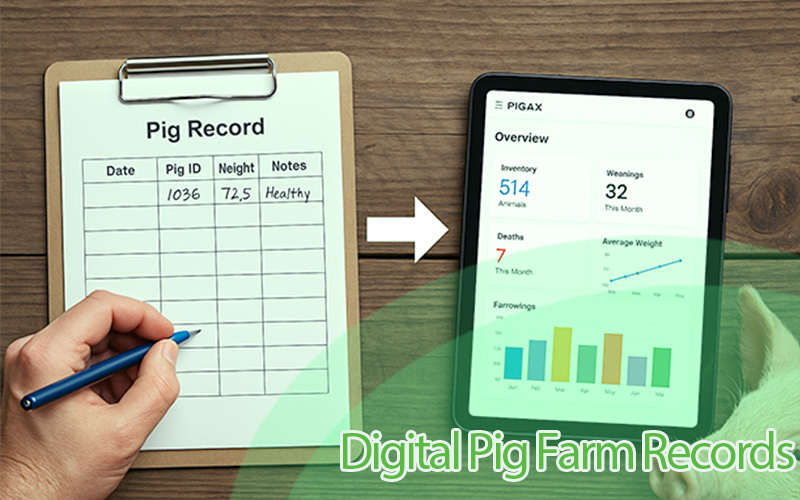How to Maintain Accurate Pig Records: A Complete Guide with Pigax
Running a successful pig farm goes beyond feeding and selling pigs. One of the most overlooked secrets to a healthy, profitable piggery is accurate and consistent record-keeping. Pig records are not just numbers and names in a notebook; they are the backbone of informed decision-making on the farm. When kept correctly, these records offer a clear window into your herd's health, breeding progress, feed consumption, medication cycles, and overall farm performance.
At Pigax, we understand how valuable your time is, especially when managing dozens or even hundreds of pigs. That’s why we’ve made it easier for farmers to maintain accurate, organized records without the burden of paperwork. In this blog, we’ll walk you through the importance of maintaining pig records, what you need to track, and how you can easily do it using Pigax.
Why Accurate Pig Record-Keeping Matters
A well-managed pig record system is the foundation of a productive farm. It helps you monitor each pig’s lifecycle—from birth to maturity—ensuring that nothing slips through the cracks. For instance, knowing the exact farrowing date of a sow allows you to prepare for weaning and next breeding cycles on time. It also helps in tracking feed-to-weight ratios, which is crucial for maximizing profitability.
Beyond growth tracking, good records enable farmers to identify recurring health issues early. If a particular pen of pigs repeatedly falls ill or underperforms, reviewing their medical and feeding history can reveal patterns you might have otherwise missed. This insight gives you the chance to adjust feeding, isolate health problems, or change medication protocols before issues become expensive.
Moreover, consistent record-keeping ensures compliance with veterinary and agricultural regulations, especially for farms supplying large-scale buyers or working under government programs. Without records, it’s easy to lose track of important health treatments, vaccinations, or breeding data, all of which are vital for farm audits.
If you’re new to pig farming or struggling with low productivity, poor record-keeping may be one of the reasons holding you back. You can read more about Top Reasons Why Beginner Pig Farmers May Fail in the Piggery Business
What Information Should Be Recorded?
To fully reap the benefits of pig record-keeping, it's important to know what data matters most. Every pig on your farm should have a profile that includes basic identification details such as tag number or name, breed, and date of birth. This helps differentiate animals and track their progress individually.
Weight tracking is another crucial metric. Weighing your pigs regularly and updating the records gives you insight into growth performance. If pigs are not gaining weight as expected, it may indicate a problem with feed quality, health, or stress levels in the pen. These small insights can prevent major losses. Use a pig management software and learn how to update pig weight records
Breeding and farrowing records are also essential. Knowing when a sow was inseminated, confirmed pregnant, and expected to farrow allows you to plan resources and avoid overcrowding. When piglets are born, you should also track the number of live births, stillbirths, and any complications during delivery.
Health records, including vaccination dates, deworming schedules, and any illnesses or treatments, need to be maintained diligently. This information not only helps you respond quickly during outbreaks but also proves useful when consulting a vet.
Let’s not forget the financials. Tracking feed consumption, dung sales, and medication expenses alongside pig data provides a full view of profitability. You can learn more about linking expenses with pig performance and learn how to track pig cost accurately
How to Maintain Pig Records Using Pigax
With Pigax, managing all this information becomes simple and efficient. The platform is designed with the farmer in mind—allowing even those with little technical experience to get started right away.
To begin, you can add a new pig record from the Pig Manager section. Here, you’ll input the pig’s name, breed, date of birth, and identification tag. You can then assign the pig to a specific group or pen. This allows you to organize your pigs by age, type, or purpose (e.g., boars for hire, pregnant sows, piglets).
As your pigs grow, you can regularly update their weight, feeding patterns, or any medical treatments received. This ensures the pig’s record remains dynamic and reflective of real-time conditions on the farm.
If a pig has reached the end of its lifecycle—whether through sale, mortality, or transfer—you can either archive or delete its record. Archiving is especially useful for maintaining historical data without cluttering your active records. You can find a complete guide in our help docs: Deleting Pig Record and Archiving Pig Record
Pigax also allows you to filter and search records by various attributes. For example, you can view only pregnant sows, check which pigs are overdue for vaccination, or generate reports based on weight gain over the past 30 days. This not only saves time but also provides the insights you need to make decisions confidently.
Tips for Keeping Your Records Consistent and Error-Free
The best system in the world still requires discipline. That’s why it’s important to build a routine around updating your pig records. Set fixed days for updating weights, logging feed consumption, and reviewing health reports. Many farmers find it helpful to do this right after their morning or evening feeding routine when observations are fresh.
Using the Pigax tag and grouping features ensures your pigs are not just listed randomly. For instance, you can create tags for "Vaccinated", "For Sale", "Sick", or "New Arrival" to make identification quick and accurate. These groupings also help when running filtered reports or when assigning tasks to different farmhands.
Accountability is another key aspect. Within Pigax, multiple user roles can be created, so different workers can update different parts of the system based on their responsibility. This prevents confusion and allows you to trace back any changes to the person who made them.
If you're just getting started with Pigax, we recommend reading our onboarding guide: Getting Started with Pigax
Conclusion
Maintaining accurate pig records isn’t just a chore—it’s a powerful strategy for running a smarter, healthier, and more profitable piggery. With tools like Pigax, the process becomes seamless, automated, and even enjoyable. You’ll gain better insight into your herd, spot trends faster, and ultimately make decisions that improve both productivity and peace of mind.
Start today. Open your Pigax dashboard and give each pig the attention and data they deserve. Your future self—and your farm—will thank you.




